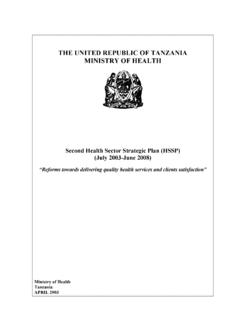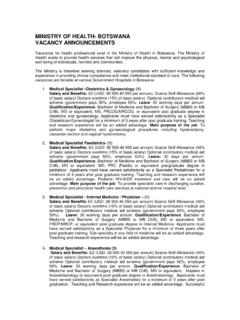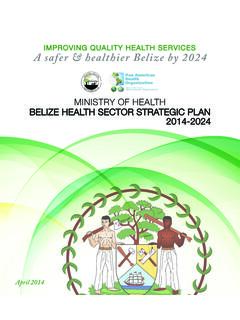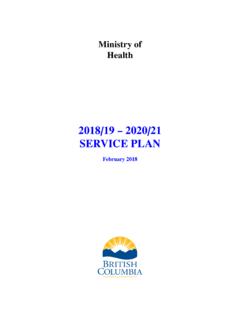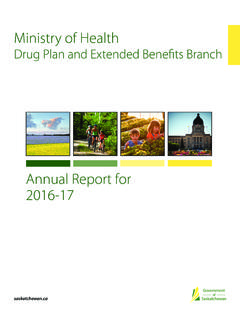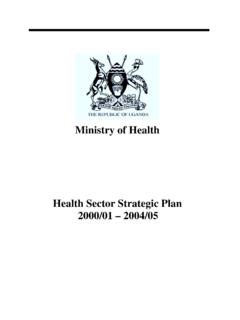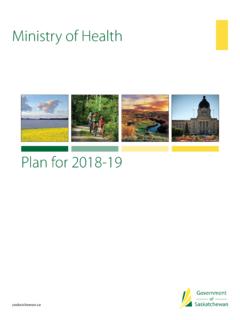Transcription of MINISTRY OF HEALTH - Partnering, Educating, …
1 REPUBLIC OF KENYA. MINISTRY OF HEALTH . NATIONAL PALLIATIVE. CARE GUIDELINES. 2013. Republic of Kenya MINISTRY of HEALTH NATIONAL PALLIATIVE CARE GUIDELINES. 2013. National Palliative Care Guidelines - 2013 1. Table of Contents Foreword 3. Executive Summary 5. Acronyms & Abbreviations 7. Acknowledgments 8. CHAPTER 1: INTRODUCTION AND BACKGROUND 9. Introduction 9. Goal 9. Objectives for the Guidelines 9. Benefits of palliative care 10. Strengthen National Policies And HEALTH Systems 11. Background 11. Situation analysis of Palliative Care services in Kenya 11. Rationale for the Palliative Care guidelines 12. CHAPTER 2: PALLIATIVE CARE GUIDING PRINCIPLES 13. Guiding Principles 13. Access to care 13. Multidisciplinary team approach 13. Service Delivery Model 13. Ethical and Legal Aspects of Care 14. Provision Of Palliative Care Services 15. Palliative care plan 15. Pain control 15. Pharmacological Measures 15.
2 Non Pharmacological Measures 16. Symptom Control 16. Medicines and Supplies 16. Nutrition 16. Infection Prevention and Control 17. Care of Carers 17. Psychosocial care of patients and their families 18. 2 National Palliative Care Guidelines - 2013. End of life care 19. Grief and Bereavement 19. Paediatric Palliative Care (0- 16 YEARS) 19. Paediatric Pain Control 19. Special needs for children 20. Maintaining Best Practice 20. Education and Training 20. CHAPTER 3: RESPONSIBILITIES AND AUTHORITY 21. MINISTRY of HEALTH 21. County Medical Team 21. HEALTH Facility 22. Pharmacy and Poisons Board (Medicines Regulating Authority) 22. KEMSA and facility pharmacy 22. STAKEHOLDERS 22. Patients, families and communities 23. CHAPTER 4: MONITORING AND EVALUATION OF PALLAITIVE CARE PROGRAMS 24. Palliative Care Indicators 24. Reporting Systems 26. Annex 1: ESSENTIAL PALLIATIVE CARE MEDICINES LIST 27. Annex 3: SUPERVISORY CHECK LIST FOR PC IMPLEMENTING FACILITIES 31.
3 Annex 4: REFERRAL FORM FOR HEALTH SERVICES IN PALLIATIVE CARE 34. Annex 6: PALLIATIVE CARE HOLISTIC ASSESSMENT FORM 35. Annex 7: THE WHO ANALGESIC LADDER FOR ADULTS 40. Annex 9: GUIDELINES TO WRITING A WILL 42. Definitions of Terms 43. References 45. National Palliative Care Guidelines - 2013 3. Foreword Kenya like other countries in Sub- Saharan Africa is still faced with the enormous burden of the HIV and AIDS pandemic as well as that of cancer. According to the 2007. National Survey, HIV and AIDS prevalence rates were estimated at % among the 15 to 49 years age group. The London declaration on Cancer Control in Africa in 2007, states that African countries will account for over a million cases of cancer per year'. with an estimated 88-95%of cancer patients presenting late or at end stage of disease. Patients and their families have identified effective pain relief as a main priority to improve their quality of life, and this priority is central to palliative care.
4 It is also estimated that 30- 80% of patients will have pain in the terminal phase of their disease, and that 25% of AIDS patients suffer severe pain during their terminal illness. (Katabera 1998, Moss 2000). Pain in patients with HIV/AIDS is often under diagnosed and under treated. There is also much suffering caused by other symptoms including psychological and spiritual distress. These patients urgently require palliative care services, which has been highlighted as an urgent need for patients with both HIV/AIDS and cancer. Non-Communicable Conditions (NCCs) are leading causes of morbidity and mortality globally. They contribute to over 60 % of total global mortality, out of which 80% of these deaths occur in middle and low income countries. By 2030, it is estimated that 8 0f 10 leading causes of death will be linked to NCCs. The World HEALTH Organization (WHO 2002) report on non-communicable diseases indicates that NCCs are becoming a major burden in developing counties much more so than in the developed counties and the burden is growing bigger each year.
5 WHO estimates that by 2015-2020, the number of deaths from the four leading NCCs (Cardiovascular disease, cancer, diabetes and hypertension) would increase by 21%. Kenya is faced with impending epidemic NCCs. According to WHO report (2002), total mortality due to NCCs was about 32%. For the period 2005-2007 NCCs contributed over half of the top ten leading causes of morbidity in the country (MOH, 2007). Over 37% of the Kenyan population has high blood pressure, and 12% are suffering from heart diseases, while 10% have diabetes. Every year, over 28,000 new cases of cancer 4 National Palliative Care Guidelines - 2013. are diagnosed in our hospitals while 22,100 die of cancer each year. NCCs are the cause of over 55% of all deaths recorded in our hospitals while they contribute to 50% of all hospital admissions in our public hospitals. Implementation of palliative care services is regulated by international declarations like the Cape Town Declaration (2002) and the Korean Declaration of (2005).
6 Up to 2010, Palliative care services were being championed by Non Governmental Organizations. To demonstrate government commitment for development of palliative care services, on 29th July 2010, the Director of Medical Services released a circular to 10 Level Five and Provincial Hospitals directing them to integrate palliative care services. Before then, palliative care services have been coordinated mainly by free standing hospices and a few mission hospitals. Development of these national palliative care guidelines will provide direction in the provision of palliative care services. The MINISTRY of HEALTH is appealing to all government facilities, Mission Hospitals, all institutions providing HEALTH care and Non Governmental organizations providing palliative care or wishing to open palliative care sites and those currently providing palliative care services to operate in line with these guidelines.
7 James W. Macharia Cabinet Secretary, MINISTRY of HEALTH National Palliative Care Guidelines - 2013 5. Executive Summary Palliative care is an approach that improves the quality of life of patients and their families facing the problems associated with life-threatening illness, through the prevention and relief of suffering by means of early identification and impeccable assessment and treatment of pain and other problems, physical, psychosocial and spiritual. Kenya like other countries of the world is experiencing a rising number of patients suffering from non communicable conditions like cancer, diabetes, cardiac diseases, renal failure, and chronic obstructive pulmonary disease among others. The country is still being faced with HIV/AIDS epidemic and all these patients require palliative care. It is estimated that there are million Kenyans living with HIV (KAIS 2007) and 28,000. new cases of cancer annually.
8 In 2005, the WHO projected that Africa will experience the largest increase in death rates from cardiovascular diseases, cancer, respiratory diseases and diabetes by 2015. Majority of patients present late and cure is not possible hence the need for palliation. These guidelines were developed by various knowledgeable stakeholders with an interest in palliative care. Vision, Mission and Goal The National palliative care guidelines envisions an effective and efficient national palliative care program in order to achieve the goal of providing holistic and quality palliative care services to patients and families faced with life threatening illnesses throughout the country. Key Interventions This guideline identifies the following key areas and suggests interventions in order to promote provision of holistic quality palliative care in Kenya. The list is not exhaustive and more strategies can be included as new challenges and innovations arise: To provide direction for the establishment and implementation of quality palliative care services in institutions and communities.
9 6 National Palliative Care Guidelines - 2013. To promote access to quality palliative care services, including pain and symptom control. To promote quality pediatric palliative care services. To provide a basis for ensuring availability, accessibility, safe handling and rational use of opioids for pain management, and other palliative care medications To provide basis for the development and implementation of palliative care standards in Kenya. A list of essential palliative care medicines is provided in Annex 1 as well as useful patient assessment tools. Conclusion The MINISTRY of HEALTH hopes that these guidelines will contribute positively to the development of palliative care. The guidelines will ensure that services offered are standard with an aim of improving the quality of life of patients in the best way possible. The MoH also recommends the adoption of these guidelines and remains committed to providing technical support through these processes.
10 Dr. Francis Kimani Dr. S. K. Sharif Director of Medical Services Director of Public HEALTH & Sanitation MINISTRY of HEALTH MINISTRY of HEALTH National Palliative Care Guidelines - 2013 7. Acronyms & Abbreviations AIDS Acquired immune deficiency syndrome APCA African Palliative Care Organization ART Anti-retroviral therapy ARV Anti-retroviral CBO Community Based Organization CD Controlled Drugs CHAK Christian Hospitals Association of Kenya CO Clinical Officer CPD Continued Professional Development EOL End of Life FBO Faith Based Organization GoK Government of Kenya HBCC Home Based Community Care HIV Human Immunodeficiency Virus HPCT Hospital Palliative Care Team KEHPCA Kenya Hospices and Palliative Care Association KEMSA Kenya Medical Supplies Agency KEPH Kenya Essential Package for HEALTH M, E & R Monitoring, evaluation and Reporting MO Medical Officer MOH MINISTRY of HEALTH NASCOP National AIDS and STD Control Program NCCs Non-communicable Conditions NGO Non-governmental Organisation ORS Oral Rehydration Salts PC Palliative Care PLWHA People Living with HIV and AIDS.
